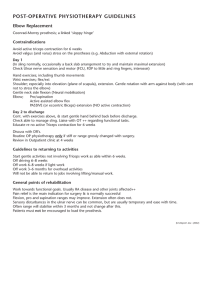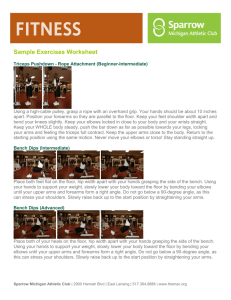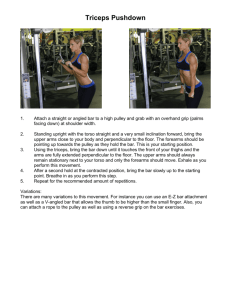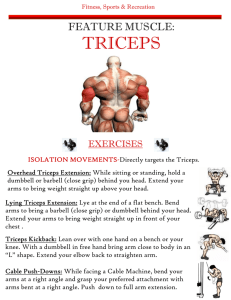Document 13521398
advertisement
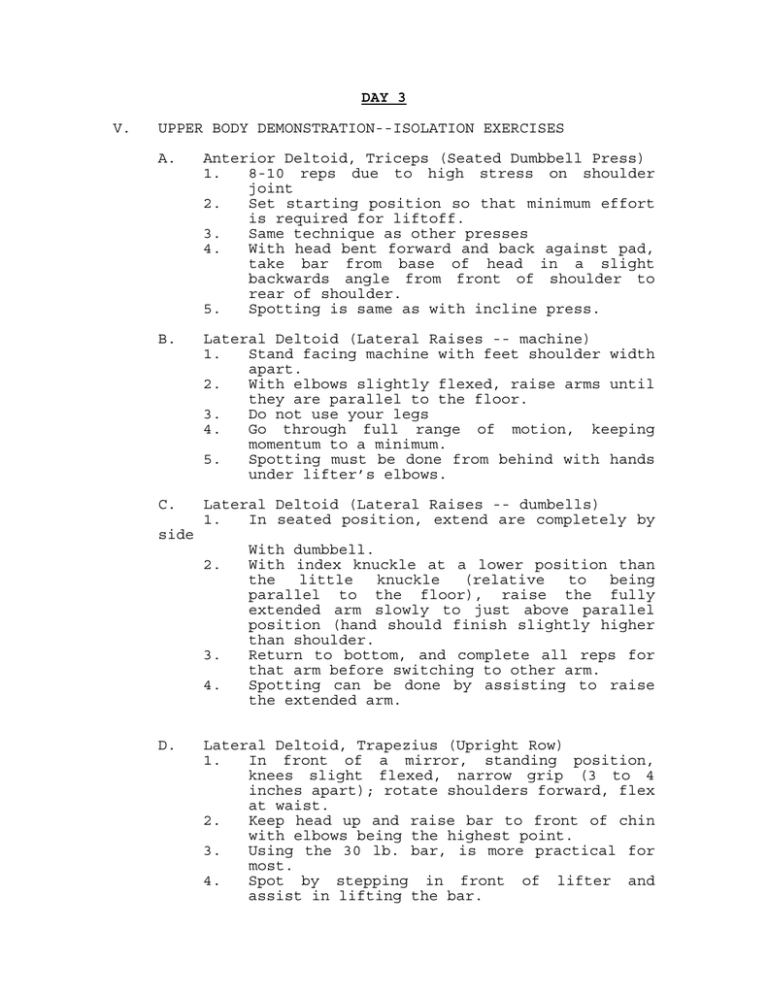
DAY 3 V. UPPER BODY DEMONSTRATION--ISOLATION EXERCISES A. Anterior Deltoid, Triceps (Seated Dumbbell Press) 1. 8-10 reps due to high stress on shoulder joint 2. Set starting position so that minimum effort is required for liftoff. 3. Same technique as other presses 4. With head bent forward and back against pad, take bar from base of head in a slight backwards angle from front of shoulder to rear of shoulder. 5. Spotting is same as with incline press. B. Lateral Deltoid (Lateral Raises -- machine) 1. Stand facing machine with feet shoulder width apart. 2. With elbows slightly flexed, raise arms until they are parallel to the floor. 3. Do not use your legs 4. Go through full range of motion, keeping momentum to a minimum. 5. Spotting must be done from behind with hands under lifter’s elbows. C. Lateral Deltoid (Lateral Raises -- dumbells) 1. In seated position, extend are completely by side With dumbbell. 2. With index knuckle at a lower position than the little knuckle (relative to being parallel to the floor), raise the fully extended arm slowly to just above parallel position (hand should finish slightly higher than shoulder. 3. Return to bottom, and complete all reps for that arm before switching to other arm. 4. Spotting can be done by assisting to raise the extended arm. D. Lateral Deltoid, Trapezius (Upright Row) 1. In front of a mirror, standing position, knees slight flexed, narrow grip (3 to 4 inches apart); rotate shoulders forward, flex at waist. 2. Keep head up and raise bar to front of chin with elbows being the highest point. 3. Using the 30 lb. bar, is more practical for most. 4. Spot by stepping in front of lifter and assist in lifting the bar. E. Pectoralis Group (Dumbbell Flies) 1. Lying down on back of a bench 2. Start with pair of dumbbells directly over shoulders with arms extended, dumbbell heads facing each other. 3. Flex elbows to about 160 degrees and bring arms down towards floor with dumbbells still in line with shoulders while rotating dumbbells outward so that they are perpendicular to the arm. 4. When dumbbells reach chest level, return to starting position. Do not change elbow angle. 5. Difficult to spot due while avoiding changing the elbow angle. F. Pectoralis Group (Flies -- machine) 1. Adjust seat so that upper arms are parallel to floor while doing exercise. 2. C oncentrate on: a. Minimum momentum b. Keep head and neck against pads. c. Keeping wrists, and elbows even with shoulders so that arms are parallel to the floor. 3. Go through full range of motion. 4. Spot by standing in front of lifter and assisting in bringing the handles together. G. Pectoralis Group (Cable-Crossover Flies) 1. Standing position, knees flexed, flexed forward at the waist. Use the top attachments on the inside of the multi-purpose unit. 2. Bring hands (holding the handles) together by moving arms in a path that are perpendicular to the torso. 3. It is best to keep the arms flexed slightly at the elbow. 4. In order to get maximum contraction the elbows must come as close together as possible. Thus, the hands should actually cross. H. Triceps (Triceps Extensions -- Cable-standing) 1. Feet shoulder width apart, knees slightly flexed, or one foot behind the other. Flex slightly at waist. Use the top attachment on the side of the multi-purpose unit. 2. Starting position is with elbows at side and back of hands as close to chest as possible. 3. While keeping elbows in place, pull bar down until arms are fully extended--return to starting position. 4. M inimize momentum. 5. Stress full range of motion. 6. To spot, step in front of lifter and assist in pulling bar down. I. Triceps (Triceps Extensions -- Cable-standing) 1. Standing position, feet close together, knees slightly flexed. Use the top attachment on the side of the multi-purpose unit. 2. One arm at a time, elbow at side and in line with shoulder, forming a line perpendicular to the floor. 3. Start with maximum flexion at the elbow joint, palm up. (can be done with palm down as well) 4. Bring the handle down by pivoting around the elbow without moving the elbow. 5. M inimize momentum. 6. Stress full range of motion. 7. To spot, step in front of lifter and assist in pulling handle down. J. Triceps (Triceps Extensions -- Cable-kneeling) 1. Brace feet against machine. 2. Do not allow elbow to go beyond edge of bench, flatten arm-pits to the back of bench. 3. Pull bar around and over head to gain starting position. 4. M inimize momentum. 5. Stress full range of motion. 6. To spot, step in front of lifter and assist in pulling bar down. K. Triceps (Triceps Extensions -- Dumbbell-sitting) 1. Use either one arm or both by putting thumb and forefinger around dumbbell. 2. With arms overhead, form a line perpindicular to the floor with your elbow to shoulder. 3. Allowing maximum range of motion, extend arm from being bent at elbow to fully extended. Do not allow elbow to change position. L. Triceps (Triceps Extensions -- Dumbbell-kneeling) 1. Kneeling on a bench or leaning over, flex elbow with dumbbell so that the dumbbell is at chest level. 2. Raise elbow so that it is stays higher than shoulder, allowing work against gravity throughout range of motion. M. Triceps (Triceps Extensions – Dumbbell-Lying) 1. Lying on a bench, lift the dumbbells overhead in a bench press fashion (grip = palms facing each other) 3. 2. Keep lower contact starting Keep your your elbows pointed directly upward, the dumbbells until your forearms make with your shoulders. Lift dumbbells to position by extending your elbows. shoulders fixed
